
Lawrence Sheriff School is a boys' grammar school in Rugby, Warwickshire, England. The school is named after Lawrence Sheriff, the Elizabethan founder of Rugby School. Lawrence Sheriff School was founded in 1878, in order to continue Sheriff's original bequest for a free grammar school for the boys of Rugby and surrounding villages, which had originally been fulfilled by Rugby School, until the latter moved to become a fee-paying public school in the 19th century. The school's name is often shortened to 'LSS', or often just 'Sheriff'. The school has historically run in partnership with Rugby High School for Girls, a nearby grammar school.

Sydney Grammar School is an independent, fee-paying, non-denominational day school for boys, located in Sydney, Australia.

Huddersfield New College is a former grammar school and current sixth form college located in Salendine Nook on the outskirts of Huddersfield, in the county of West Yorkshire, England. The current principal is Doctor Alban. On 17 May 2016 the college was assessed as 'Outstanding' in all 6 inspection domains following an OFSTED review. They are the first Sixth Form College to receive such an accolade under the new inspection framework.

The Liverpool Institute High School for Boys was an all-boys grammar school in the English port city of Liverpool.

Pretoria Boys High School is a public, tuition-charging, English-medium high school for boys situated in the suburb of Brooklyn in Pretoria in the Gauteng province of South Africa, founded in 1901 by Alfred Milner, 1st Viscount Milner.

Batley Grammar School is a state-funded co-educational free school in Batley, West Yorkshire, England, for pupils aged 4 to 16.

Saltus Grammar School, founded in 1880, is an independent school in Pembroke Parish, Bermuda. It was a boys' school until 1992, when it became co-educational. It has two campuses, one for the Lower Primary and one for the Upper Primary, Middle School and Secondary.

Davenant Foundation School is a Christian Ecumenical secondary school, founded in 1680, currently in Loughton, Essex, England.

Queen Elizabeth's High School is a mixed grammar school in Gainsborough, Lincolnshire, England. The school, established in 1983, but with a timeline to 1589, is an amalgamation of the previous Gainsborough High School and Queen Elizabeth's Grammar School.

George Street is a street in central Oxford, England. It is a shopping street running east–west.
Oxford Spires Academy is a state funded secondary school for children aged 11–18 in Glanville Road, East Oxford, England formerly known as Oxford Community School and The Oxford School. Formerly sponsored by the CfBT Education Trust it is currently part of the Anthem Schools Trust.

Sir George Monoux College is a sixth form college located in Walthamstow, London. It is a medium-sized college with around 1,620 full-time students as of 2018.

Labor omnia vincit or Labor omnia vincit improbus is a Latin phrase meaning "Work conquers all". The phrase is adapted from Virgil's Georgics, Book I, lines 145–6: ...Labor omnia vicit / improbus. The poem was written in support of Augustus Caesar's "Back to the land" policy, aimed at encouraging more Romans to become farmers.
The Harvey Grammar School is located in Folkestone, Kent, England. It is a grammar school with academy status founded by the family of William Harvey in 1674.

Hutchesons' Grammar School is an independent day school for boys and girls aged 3–18 in Glasgow, Scotland. It was founded as Hutchesons' Boys' Grammar School by George Hutcheson and Thomas Hutcheson in 1641. Prospective pupils must sit an entrance test and interview to gain admission. Hutchesons' is one of the 20 oldest schools in Scotland and counts the First Minister of Scotland, several members of the House of Lords and the first female lawyer in the United Kingdom among its alumni. Former pupils are known as Old Hutchesonians and the Rector is Michael Martin. The school now has around 1,300 pupils across its Pre-school, Junior and Senior Schools and is governed by The Governors of Hutchesons' Educational Trust.
Graham School is a coeducational secondary school in the west of Scarborough in North Yorkshire, England. It is situated to the west of the town within 22 acres (8.9 ha) of grounds. The school is on Woodlands Drive. The lower site on Lady Edith's Drive closed on 23 June 2017.

Torquay Boys' Grammar School is an 11–18 selective boys grammar school in Torquay, Devon, England. As of May 2023, it had 1,087 students. The school was founded in 1904. It is situated in Shiphay, south of Torbay Hospital, not far from the A3022 and Torre railway station as well as being directly next to Torquay Girls Grammar School.
Theodore William Chaundy was an English mathematician who introduced Burchnall–Chaundy theory.
Kilburn Grammar School was an English grammar school which opened in 1898 in Kilburn, north-west London. The school ceased to exist in 1967.

Wandsworth School was a local authority maintained boys' secondary school in Southfields, London. Established in 1895, it became a selective grammar school, then an all-ability comprehensive school, before merging in 1986 and finally closing in 1991. From the 1960s it became well known for its choir.
















